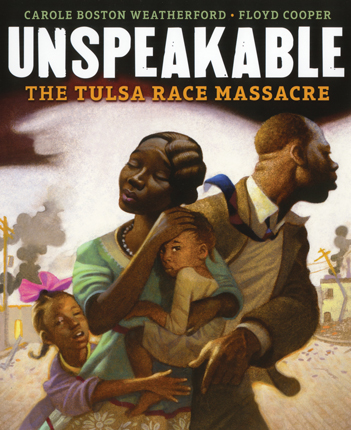| Unspeakable : the Tulsa Race Massacre Author: Weatherford, Carole Boston | ||
| Price: $23.08 | ||
Summary:
Provide a powerful look at the 1921 Tulsa race massacre, one of the worst incidents of racial violence in our nation's history.
| Illustrator: | Cooper, Floyd |
Video Preview:
| Accelerated Reader Information: Interest Level: MG Reading Level: 5.80 Points: .5 Quiz: 511494 |
Awards:
Caldecott Honor, 2022
Caldecott Honor, 2022
Coretta Scott King Author Award, 2022
Coretta Scott King Illustrator Award, 2022
Robert F. Sibert Informational Book Honor, 2022
Reviews:
Kirkus Reviews (+) (12/01/20)
School Library Journal (+) (02/01/21)
Booklist (+) (12/15/20)
The Hornbook (+) (00/01/21)
Full Text Reviews:
Booklist - 12/15/2020 *Starred Review* “Once upon a time in Tulsa, there was a community called Greenwood.” This Black community was rich in money, love, and culture. So much so that white people searched for any reason possible to tear that community down. This tragic, painful event in American history calls into question notions of freedom, equality, and opportunity ostensibly promised to Black Americans following the emancipation proclamation, and it's particularly pertinent in the current sociopolitical landscape, which is throwing a spotlight on systemic racism in America. Weatherford draws on the folktale flourish “once upon a time” to set a scene that feels far away and removed from our present reality, while Cooper’s soft strokes of muted greens and sepia browns capture the event in a haze of both joy and mourning for the beauty of what Black Tulsa was. Unlike many historical picturebooks, Weatherford's doesn’t shy away from naming white people as the perpetrator. This will cause obvious discomfort for some but will be the catalyst for conversation and change if read with eyes toward justice. Included are author’s and illustrator’s notes that explore their personal connections to the Tulsa Race Massacre in addition to photographs of Greenwood at the time of the massacre and today. Ideal for classroom libraries and a deeper study of American history, this title is a must-have for those seeking the painful and complete truth. - Copyright 2020 Booklist.
School Library Journal - 02/01/2021 Gr 3–6—One hundred years ago, the Greenwood district of Tulsa, OK, was a prosperous Black community. Restaurants, beauty salons, movie theaters, and dozens of other businesses thrived along "Black Wall Street." Cooper's sepia-tone illustrations depict the bustle of everyday life as people hurried to shops or churches and gathered with friends. A stark spread signals the tragic turning point that resulted in the decimation of Greenwood's Black community. A 17-year-old white woman elevator operator accused a 19-year-old Black man of assault. Incited by calls to action printed in white-owned newspapers, thousands of armed white men headed to the jail, where they met 30 armed Black men determined to stop a lynching. The confrontation resulted in the deaths of two Black men and 10 white men. Angry that they didn't get to the jailed Black man, a white mob invaded the town, looted, and committed arson. The police did nothing to protect the Black citizens. Up to 300 Greenwood residents were killed, and more than 8,000 were left homeless. Seventy-five years passed before an official investigation occurred. Cooper's illustrations are infused with a personal connection. Not only did he grow up in Tulsa, but Cooper also heard his grandpa's stories of surviving the events. The powerful photo spread on the endpapers documents the destruction and smoking ruins. Cooper's final illustrations of Tulsa's Reconciliation Park offer a bit of hope. Weatherford's author's note provides additional background. VERDICT This moving account sheds light on shameful events long suppressed or ignored. All collections should consider this title's value in providing historical context to current conversations about racism and America's ongoing legacy of white supremacy.—Kathy Piehl, Minnesota State Univ. Lib., Mankato - Copyright 2021 Publishers Weekly, Library Journal and/or School Library Journal used with permission.



